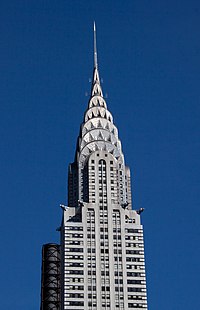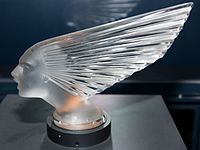
Back Art Deco Afrikaans فن زخرفي Arabic ارت ديكو ARZ Art Decó AST Ar-deko Azerbaijani Ар-дэко Byelorussian Артдеко Bulgarian আর দেকো Bengali/Bangla Art Deco BS Art déco Catalan
This article may be in need of reorganization to comply with Wikipedia's layout guidelines. (August 2023) |
Top to bottom: Chrysler Building in New York City (1930); poster for the Chicago World's Fair (1933); and Victoire hood ornament by René Lalique (1928) | |
| Years active | c. 1910s–1950s |
|---|---|
| Location | Global |
Art Deco, short for the French Arts décoratifs (lit. 'Decorative Arts'),[1] is a style of visual arts, architecture, and product design, that first appeared in Paris in the 1910s (just before World War I),[2] and flourished in the United States and Europe during the 1920s to early 1930s. Through styling and design of the exterior and interior of anything from large structures to small objects, including how people look (clothing, fashion, and jewelry), Art Deco has influenced buildings (from skyscrapers to cinemas), bridges, ships, ocean liners, trains, cars, trucks, buses, furniture, and everyday objects including radios and vacuum cleaners.[3]
Art Deco got its name after the 1925 Exposition internationale des arts décoratifs et industriels modernes (International Exhibition of Modern Decorative and Industrial Arts) held in Paris.[4] Art Deco has its origins in bold geometric forms of the Vienna Secession and Cubism. From its outset, it was influenced by the bright colors of Fauvism and of the Ballets Russes, and the exoticized styles of art from China, Japan, India, Persia, ancient Egypt, and Maya.
During its heyday, Art Deco represented luxury, glamour, exuberance and faith in social and technological progress. The movement featured rare and expensive materials, such as ebony and ivory, and exquisite craftsmanship. It also introduced new materials such as chrome plating, stainless steel and plastic. In New York, the Empire State Building, Chrysler Building, and other buildings from the 1920s and 1930s are monuments to the style. The largest concentration of art deco architecture in the world is in Miami Beach, Florida.[5]
In the 1930s, during the Great Depression, Art Deco gradually became more subdued. A sleeker form of the style, called Streamline Moderne, appeared in the 1930s, featuring curving forms and smooth, polished surfaces.[6] Art Deco was a truly international style, but its dominance ended with the beginning of World War II and the rise of the strictly functional and unadorned styles of modern architecture and the International Style of architecture that followed.[7][8]
- ^ McLaughlin, Katherine; Stamp, Elizabeth (26 June 2023). "Art Deco Architecture: Everything You Need to Know". Architectural Digest. Retrieved 28 December 2023.
- ^ Texier 2012, p. 128.
- ^ Hillier 1968, p. 12.
- ^ Benton, Benton & Wood 2003, p. 16.
- ^ "Miami Beach celebrates 100 years of Art Deco style, culture". CBS news. Retrieved 20 January 2025.
- ^ Renaut, Christophe and Lazé, Christophe, Les Styles de l'architecture et du mobilier (2006), Editions Jean-Paul Gisserot, pp. 110–116
- ^ Benton, Benton & Wood 2003, pp. 13–28.
- ^ Criticos, Mihaela (2009). Art Deco sau Modernismul Bine Temperat - Art Deco or Well-Tempered Modernism (in Romanian and English). SIMETRIA. pp. 14, 16. ISBN 978-973-1872-03-2.


